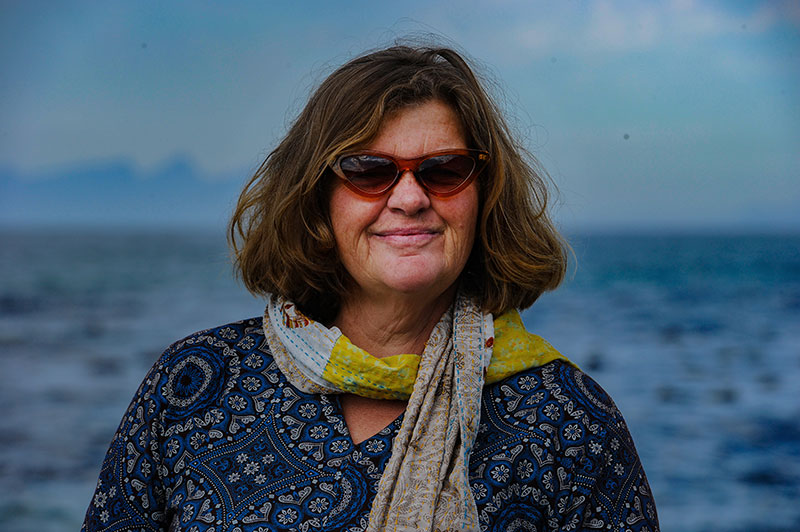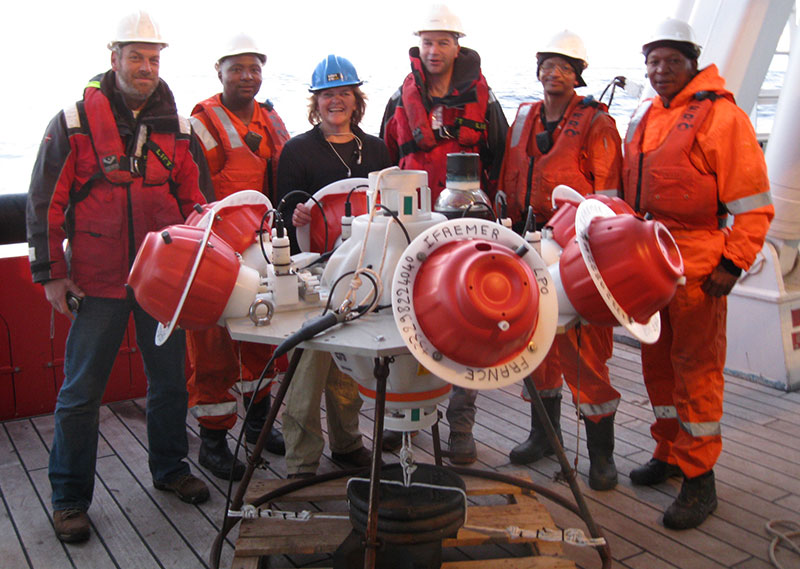Train researchers for big science in oceanography
21 April 2021 | Story Helen Swingler. Voice Neliswa Sosibo. Read time 10 min.In 1983 Professor Isabelle Ansorge’s father took the 14-year-old out of school for six months to join him aboard a Polish barquentine and “class afloat”, the RV Pogoria, on its voyage around Africa. Amid billowing sails and spume, she tackled maritime chores, cleaning and painting. So began a love song to the sea.
“That changed my life, and I sit where I am because of that one experience,” Professor Ansorge said in her inaugural lecture on 14 April.
These lectures (now presented online) are opportunities for new professors at the University of Cape Town (UCT) to showcase their work to a broad audience. Titled “Teaching the many (50) shades of blue – while the world is changing its shade”, the presentation was the first in the Vice-Chancellor’s Inaugural Lecture programme for 2021.
Ansorge’s oceanographic research had become “the focus of a remarkable academic career”, Vice-Chancellor Professor Mamokgethi Phakeng said in her welcome.
Gender milestones in oceanography
Ansorge was the first woman at UCT to obtain a PhD in oceanography and the first to head the department in this male-dominated field, Dean of Science Professor Maano Ramutsindela added in his introduction.
“In those formative years of our democracy, Isabelle was busy creating a niche in oceanography.”
“Isabelle has a long association with UCT. I donʼt want to reveal her age,” he quipped, “but she was at UCT as early as 1993. In those formative years of our democracy, Isabelle was busy creating a niche in oceanography.”
Through a career in observational oceanography, that niche in research is creating a greater awareness of the ocean’s physical, biogeochemical and ecological response to climate change; the first part of her lecture.
The second part introduced the audience to the SEAmester programme aboard the ice-breaker and research vessel the SA Agulhas II, South Africa’s flagship marine and polar research vessel. SEAmester’s floating university offers all earth system postgraduates across South Africa a free and fair opportunity to gain access to this research platform.
It’s an unforgettable experience, said Ansorge, with a nod to some formidable storms they’ve braved in the past when the ship’s 12-metre-high bow has disappeared under rolling breakers.
Currents and climate change
Ocean current systems interchange the warm and cold waters of the world’s oceans and are essential to regulating climate. The Meridional Overturning Circulation (MOC) is a system of surface and deep ocean currents that extend across the globe.
“Itʼs important to understand the importance of the oceans and the global conveyor belt that links all ocean basins,” said Ansorge. “We have a strong connectivity between the Pacific, Indian and Atlantic oceans. The surface flow brings warm water around the planet. And the colder flow sits deep in the interior of the worldʼs ocean. So, you have this overturning as water sinks down into the deep oceans and then pops up again somewhere in the Southern Ocean.”
Ansorge described the example of South Africa’s own current dynamics; the warm Agulhas current flowing south-west leaks salt into the colder Atlantic Ocean. It’s part of the Atlantic Meridional Overturning Circulation (AMOC), a major global current system that connects both north and south Atlantic oceans.
“But perhaps a knock-on effect of climate change is going to be a gradual cooling in the Northern Hemisphere.”
It flows northwards as far as Norway, feeding warm salty water from the south into the Gulf Stream. This is responsible for the temperate conditions found in northern latitude countries such as England and may over time mitigate changes in freshwater brought on by an increase in ice melt from Greenland into the North Atlantic.
But a new development has oceanographers worried, said Ansorge. Evidence shows that the AMOC circulation flow is slowing in the face of climate change.
“That fresh water is making water in the Gulf Stream extremely buoyant and changing its ability to extend as far north as it currently does. The increase in fresh water also results in its ability to sink into the deeper layers and form that deep ocean current. Essentially, we’re seeing a reduction in the water that is burrowing down into the deep ocean. It’s almost as if the Greenland melt water is creating a lid on the surface conditions.”
Oceanographers are perplexed.
“But perhaps a knock-on effect of climate change is going to be a gradual cooling in the Northern Hemisphere around Europe and North America, just because of the Greenland melt.”
The situation highlights the importance of monitoring oceans, said Ansorge. “And as an oceanographer you need to get instruments into the ocean to measure the physical and chemical changes.”

Until 2013 mooring arrays in the North Atlantic were able to monitor the MOC: the RAPID/MOCHA array. It was obvious, she added, that with global warming, changes happening between the South and North Atlantic sectors had to be considered in tandem.
In 2013 South Africa deployed a long-term monitoring array: an observation network of instruments that form the South Atlantic Meridional Ocean Circulation (SAMOC-SA) system. The initiative is led by Ansorge, Marcel van den Berg and UCT honorary research associate Dr Tarron Lamont, both of the Department of Environmental Affairs’ Oceans and Coasts division in Cape Town.
Thanks to the SA Agulhas II, finally an array of eight Current Pressure Inverted Echo-Sounder (CPIES) moored instruments were deployed into the South Atlantic as part of the SAMOC-SA system. This completes a network of eight bottom-moored CPIES and four deep-ocean moorings that record vertical acoustic travel time and near-bottom pressure and velocity. From these, measurements such as temperature, salinity and north–south velocity throughout the water column can be inferred.

“It’s a huge international programme aimed at measuring the volume and rate of flow of water moving northwards,” said Ansorge. “While the dataset is relatively young (since only 2013), we need to get started with these measurements to understand better how this flow is changing over years and eventually decades. Of interest is to quantify the salt leakage coming from the Indian into the Atlantic and try to understand whether that is changing, and what the variability scale is: Are we looking at a timeframe of one year, 10 years, or more than two, three decades?”
Training new postgraduates
Because of the long-term nature of this project, universities like UCT need to train new generations of postgraduates to continue this work; people who have the same passion for the ocean that ignited Ansorge years ago.
This is SEAmester’s role. In five years (the voyage was cancelled last year because of COVID-19), 186 students have experienced SEAmester; 68% of those are furthering their studies, others have moved into the work field, travel and business. They get 200 applications annually for 45 berths. Crew include 30 academics and other selected researchers. But they prioritise women and black students, said Ansorge. The participant split is: 46% black, 36% white, 5% Indian and 13% coloured.
“We have to attract young researchers into the region, but weʼve also got to retain them. Weʼve got to excite them, enthuse them and give them a tangible experience where they can go to sea.”
SEAmester is run in parallel with the South African Environmental Observation Networkʼs Egagasini Node Agulhas System Climate Array (ASCA) monitoring line managed by Professor Juliet Hermes and Dr Tammy Morris.
“There is a very strong need to get students onto the ship, and the funder – the Department of Science and Innovation – has recognised that we have to attract young researchers into the region, but weʼve also got to retain them. Weʼve got to excite them, enthuse them and give them a tangible experience where they can go to sea and feel that they have learned something that they would never learn in the classroom – and that they are making a meaningful contribution to science.”
It seemed fitting that the vote of thanks after Ansorge’s lecture was delivered by Liisa Shangheta, the chairperson of the UCT oceanography postgraduate studentsʼ committee.
Shangheta grew up in the Kavango Region in northern Namibia. At 15, she saw the sea, the country’s entire western border, for the first time. Going to sea aboard the SA Agulhas II in 2019 as part of the annual logistic voyage to the Prince Edward Islands to collect data for her MSc was “the highlight of my life”, Shangheta said.
 This work is licensed under a Creative Commons Attribution-NoDerivatives 4.0 International License.
This work is licensed under a Creative Commons Attribution-NoDerivatives 4.0 International License.
Please view the republishing articles page for more information.
Listen to the news
The stories in this selection include an audio recording for your listening convenience.












































































































































































































































































































































































































